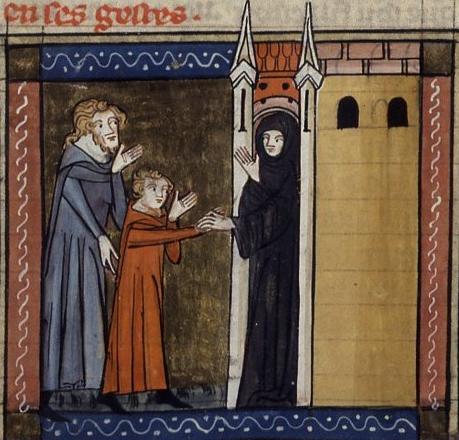
It's #InternationalMensDay, so we're going to introduce you to some trans men from history today.
Before we begin, we'd like to note there are caveats in interpreting people from the past as trans. This is discussed in our podcast episode Trans Saints and Gay Vikings, featuring @MxComan and @queertyyr - you can listen here vaginamuseum.co.uk/podcast/transs…
We'll start with a trans saint discussed in the podcast: St Marinos the Monk. Marinos lived in the 5th century, in what is now Syria or Lebanon. He became a monk as a young man - in this 14th century French illustration, he's the guy in red. 

He was recognised as a man among his fellow monks and in the surrounding area. An aristocratic woman accused him of impregnating her. Marinos didn't refute this. Instead, he accepted his expulsion from the monastery.
He went to live in the forest with the child, and befriended a deer to nurse it. In some versions of the story, the mother of the baby repented and said that Marinos was not the father. In others, it was only discovered he could not father a child after he had died.
Next up, COLONEL AMELIO ROBLES ÁVILA (1889-1984). Robles was a colonel during the Mexican Revolution, born in Xochipala. He was a soldier for decades, fighting with the Zapatistas and later General Alvaro Obregón. 

A medical examination in 1948 revealed he had received six bullet wounds in his military career. Later in his life, Robles was decorated as a veteran of the Mexican Revolution, the Revolutionary Merit Award, and the Mexican Legion of Honour.
Robles killed two men in self defence when they attacked him to force him to reveal his genitals. He was also said to threaten anyone who called him a woman with a pistol.
Another military man, JAMES BARRY (1789-1865). Barry was a military surgeon who served around the world. At the end of his career, he held the second highest medical office in the entire British Army. 

Barry made great achievements in improving sanitary conditions for soldiers and underprivileged people. He also performed the first recorded C-section in Africa where both mother and baby survived.
However, he also had a tendency to rub people up the wrong way. Florence Nightingale, who met him during the Crimean War thought he was an asshole. He frequently annoyed military officials by loudly demanding improvements for the poor - he was once arrested for this.
KARL. M. BAER (1885-1956), a German-Israeli, was one of the first trans people to receive full legal recognition. At the beginning of his career, he was sent to Galicia by B'nai B'rith to campaign for women's rights. It was there that he met the woman who would become his wife.
On his return to Germany, he met Magnus Hirschfield after beginning his transition. Together, they published Baer's semi-fictionalised memoir where he wrote under the rather wonderful pseudonym N. O. Body. He was legally recognised as male in 1907, and married his wife.
As a Jewish man and director of Berlin's section of B'nai B'rith, in 1937, he had to leave Germany. He settled in Bat Yam with his second wife where he worked as an accountant.
BILLY TIPTON (1914-1989) was a jazz musician and band leader with a music career spanning decades. He played the sax and the piano. 

Tipton never legally married, but throughout his life five women called themselves Mrs Tipton. He cheated on at least one of the Mrs Tiptons, breaking up with Maryann for Kitty Kelly.
He adopted three sons with Kitty, before separating and getting back together with Maryann. He died from a haemorrhaging peptic ulcer in 1989.
And one more man we're going to tell you about, MICHAEL DILLON (1915-1962), known later in his life as Lobzang Jivaka, a British doctor. 

Dillon is perhaps best known for publishing the book Self: A Study in Ethics and Endocrinology, discussing identity and transition from a medical perspective, and laying out arguments for treatment for trans people.
Dillon was the first trans man to undergo phalloplasty surgery, and following the publication of his book, he met Roberta Cowell, who would go on to be the first trans woman in Britain to undergo lower surgery.
Dillon performed some of the surgery himself, and connected her with his own surgeon for other procedures. He proposed to Cowell in 1951, but she turned him down.
We'll leave you with a quote from @queertyyr from the podcast episode at the top of this thread: “Queer people and trans people have always existed and we will always exist.”
Sigh, we've had to turn replies off this thread because some individuals simply cannot behave themselves and would prefer to push ideologies than learn about interesting men from history.
• • •
Missing some Tweet in this thread? You can try to
force a refresh








